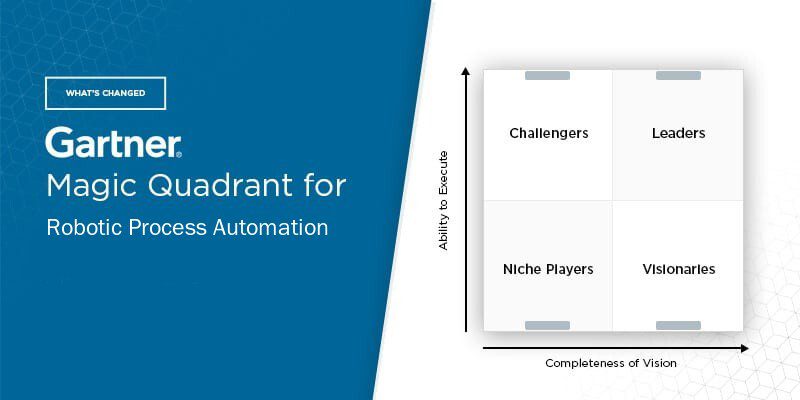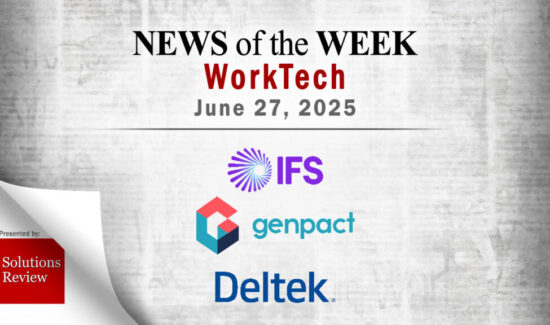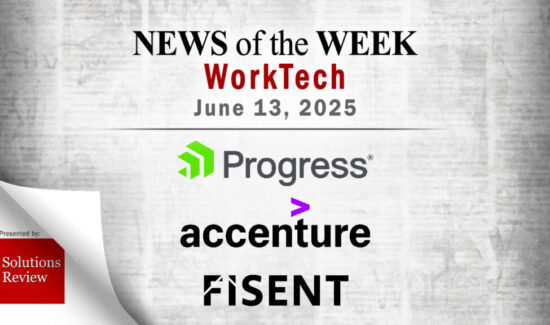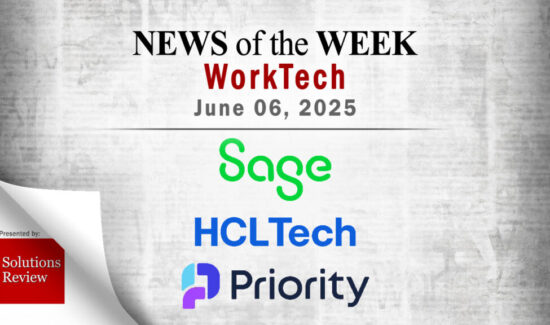What’s Changed: 2021 Gartner Magic Quadrant for Robotic Process Automation

 The editors at Solutions Review highlight what’s changed since the last iteration of Gartner’s Magic Quadrant for Robotic Process Automation and provide an analysis of the new report.
The editors at Solutions Review highlight what’s changed since the last iteration of Gartner’s Magic Quadrant for Robotic Process Automation and provide an analysis of the new report.
Analyst house Gartner, Inc. has released its 2021 Magic Quadrant for Robotic Process Automation. The researcher defines the robotic process automation (RPA) market as “the market for licensed software platforms used for building scripts to integrate any application via a user interface and a control dashboard or orchestrator. RPA platforms automate repetitive, rule-based, predictable tasks.” Gartner predicts that the RPA market will mature and consolidate through 2024, though it is currently still very fragmented as vendors in adjacent fields are starting to offer RPA capabilities.
RPA software platforms primarily utilize a combination of user interface (UI) interactions and application programming interfaces (APIs) to integrate different enterprise applications, including ERP apps, client/server systems, and mainframes, among other applications. The vendors named in this report are providers of RPA software products, rather than service providers that use RPA technologies licensed from another vendor.
At a minimum, an RPA software platform must enable citizen developers to build automation scripts; integrate with enterprise apps, mainly through UI scraping; and have orchestration and administration capabilities, including configuration, monitoring, and security. More advanced capabilities offered by some RPA tools include intelligent document processing; auto machine learning (Auto ML) and natural language processing (NLP) libraries with drag-and-drop models; and process mining and discovery. More emerging, cutting-edge features are also popping up, such as API connectors that can be orchestrated along with UI scrapers; low-code user experiences for building UI front ends for bots; and headless or serverless orchestration of automation workflows.
Gartner adjusts its evaluation and inclusion criteria for Magic Quadrants as software markets evolve. Gartner notes that a vendor being dropped from a Magic Quadrant one year does not necessarily mean that the research firm has changed its view of the vendor. Instead, it may reflect a change in the market or a change of focus by a vendor. Antworks, HelpSystems, Jacada, and Kofax were dropped, as they no longer met the researcher’s inclusion criteria, while Appian, Cyclone Robotics, IBM, Kryon, Laiye, and Nintex were all added to this year’s report.
In this Magic Quadrant, Gartner evaluated the strengths and weaknesses of 18 providers that it considers most significant in the marketplace and provides readers with a graph (the Magic Quadrant) plotting the vendors based on their ability to execute and completeness of vision. The graph is divided into four quadrants: niche players, challengers, visionaries, and leaders. At Solutions Review, we read the report, available here, and pulled out the key takeaways.
As in last year’s edition of this report, the niche player’s quadrant is the most densely populated, with eight vendors earning this distinction. While furthest from the Y-axis of the graph, NTT is placed the closest to the X-axis. This provider is using its business services and technology capabilities to sell RPA to many customers, including through distributors and partners. This strategy has been particularly effective in driving sales growth outside of Japan. NTT’s closest competition in this section of the graph is Samsung SDS, which has a strong focus on AI and ML. Its platform includes a chatbot, integrated optical character recognition (OCR), and native AI.
Nintex is also a niche player, as well as a new addition to this iteration of the Magic Quadrant. Nintex’s customers are from across all industries, but its RPA offering is mainly used by financial services and banking organizations. SAP is placed closest to the center of the graph in the niche player’s section. This placement could be due to SAP’s strong vision for application-focused automation, as well as its recent acquisition of Signavio, which positions the vendor to offer an end-to-end integrated solution that includes RPA, process mining, BPM, and cloud ERP capabilities.
The remaining niche players, IBM, Kryon, Cyclone Robotics, and Laiye are all closely clustered together. Industry giant, IBM, has been acquiring various automation technologies, including RPA, to complement its existing automation portfolio. The vendor is also focused on investing in AI and complex orchestration of end-to-end IT and business automation. Kryon’s placement in this year’s report could be a result of its integration of process discovery and task mining with RPA to support scaled automation programs. Cyclone Robotics sets itself apart from the other providers named in this report through its investment in AI to deliver services like Cyclone Intelligent Robotic Interface (CIRI) and the Cyclone AI Skill Platform. Rounding out the niche players quadrant of the graph is Laiye. Currently, Laiye has limited visibility outside of the Asia/Pacific region, but its revenue growth, investor capital, and plans to expand across the region could disrupt the rapidly growing RPA market in the future.
The challenger’s section of this year’s report is the least crowded, only containing EdgeVerve Systems and NICE, which were both challengers last year as well. EdgeVerve has a strong focus on large enterprises and draws on the existing system integration and outsourcing relationships of its parent company, Infosys. NICE’s placement on the graph is likely due to its targeting of global enterprises and contact centers by offering specialized attended bots to bolster its workforce management functionality for a range of industries.
There are four visionaries in this year’s Magic Quadrant, with Pegasystems and Servicetrace being the only two providers listed in this quadrant for consecutive years. WorkFusion was previously a leader, and Appian is a new addition to this report. WorkFusion fell only slightly in its ability to execute and is located very close to the X-axis of the graph. The provider specializes in catering to the automation needs of the banking and financial services industry and has shown superior AI/ML capabilities by augmenting its RPA technology with prepackaged ML models for specific use cases. Appian’s differentiating RPA capabilities include full-stack automation features, including automation planning, prebuilt integration with a range of artificial intelligence and machine learning services, workflow orchestration, and end-to-end life cycle support for DevOps.
Pegasystems earned the highest completeness of vision among the visionaries this year. The vendor offers X-ray Vision technology for mapping low-level screen objects to screen concepts, a process fabric layer for serverless orchestration, and an iBMPS foundation within the Pega Infinity Platform. Servicetrace’s visionary status is likely a result of its impressive feature set, which includes an intelligent process recorder, an embedded BPM engine, native test automation, ROI analytics, and patented vertical scaling.
Rounding out this year’s Magic Quadrant are the leaders: UiPath, Automation Anywhere, Microsoft, and Blue Prism. Winning out in the ability to execute is UiPath, which could be due to its demonstration of viability and stability with its $29 billion IPO and significant revenue growth between 2019 and 2020. Automation Anywhere boasts the strongest completeness of vision out of this year’s leaders. Its RPA offering delivers a multi-person user experience, guided navigation, reusable AI/ML libraries, strong native security, and an intuitive analytics dashboard.
Microsoft, a visionary in last year’s report, is a new leader this year. This category change is possibly a result of the fact that its RPA offering with API orchestration can integrate multiple systems of record to automate routine data transcription work. Blue Prism, the remaining leader, is located in almost the space place near the Y-axis as it was in last year’s Magic Quadrant. Blue Prism has a vertical-market strategy with industry-focused experts, campaigns, partners, and accelerator tools. Additionally, the vendor offers 42 industry-specific solutions and has a user base that spans most industries.
Read Gartner’s Magic Quadrant for Robotic Process Automation.




















